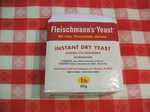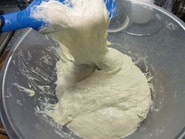The reaction is catalyzed by oven heat, the reducing sugars react with amino acids in the bread, cookie, pretzel and biscuit dough yielding a delectable aroma and a golden brown exterior.
The Maillard reaction which occurs most readily when the surface temperature of the food is more than 300 degrees Fahrenheit. The reaction takes place only when both protein and carbohydrates or sugars are present. Cooked at high heat, protein breaks down into its building blocks, amino acids, which then react with a group of sugars known as simple sugars. The reacting amino acids and sugars rearrange themselves to form ring-type structures that reflect light in such a way that the food takes on a brown hue. These transformations also produce the flavor and aroma compounds, which combine with one another to produce even more tastes and smells. Ranging from malty, grassy, and chocolaty to oniony, meaty, and earthy, they depend on the exact composition of particular foods.
In baked items the type of sugar in the recipe can have a great effect on results from the Maillard reaction. Baked items sweetened with sugar alcohols (xylitol, sorbitol, erythritol, etc) don’t brown? Those sweeteners don’t participate in the Maillard reaction. Also be careful subbing Splenda for sugar – Splenda doesn’t brown in many baked goods, so you’ll need to make a few recipe adaptations, if you want a color change when baked.
Caramelization of a food happens at a higher temperature around 320 degrees Fahrenheit. Unlike the Maillard reaction, caramelization is exclusively the breakdown of sugar molecules under high heat. Sugars such as glucose and sucrose unravel, and a wealth of sweet, bitter, and nutty flavor molecules are formed. These chemical reactions not only bring about a color change, they also produce hundreds of flavor compounds that create the rich, savory notes and appetizing aromas we associate with baked, roasted, grilled, and seared dishes The aromas that are noticeably absent from foods cooked by wet methods like steaming, boiling, and poaching.
For a food to reach such high surface temperatures, it must be fairly dry on the outside. When in direct contact with a hot skillet or surrounded by the scorching air of a 400 F oven, the water molecules on the surface of foods quickly vaporize, resulting in the familiar sizzling sound of searing or roasting foods. Once all the moisture has evaporated, the dehydrated exterior of the food becomes hot enough to trigger the Maillard reaction in just a few minutes.
By contrast, foods cooked by wet methods are only able to reach 212 F, the boiling point of water. One product I use often in my kitchen is the crock pot, it's not known for browning the food, so most recipes have you sear the meat before you put it into the crock. The Maillard reaction can take place at lower temperatures, but it takes much, much longer, such as when meat broth develops a dark color and rich flavors after hours of simmering.
The ratio of the Maillard reaction to caramelization that transpires on a piece of food depends on its protein and carbohydrate content. Carrots, for example, have lots of carbohydrates, so roasting these root vegetables will result in considerably more caramelization than Maillard compounds. Seared steak, on the other hand, will have been browned and enriched mostly from the Maillard reaction.
I hope this information will give you some insight into the chemistry of why food browns when baked and the wonderful aromas and tastes it creates.
Sources:
Food Explainer thanks Jeff Culbertson of Washington State University.


 RSS Feed
RSS Feed
